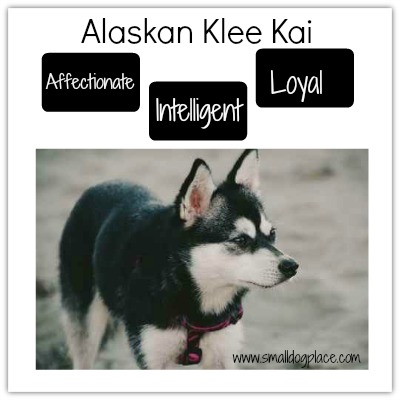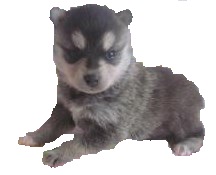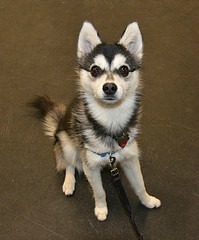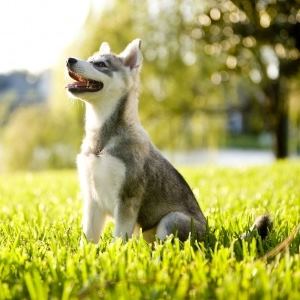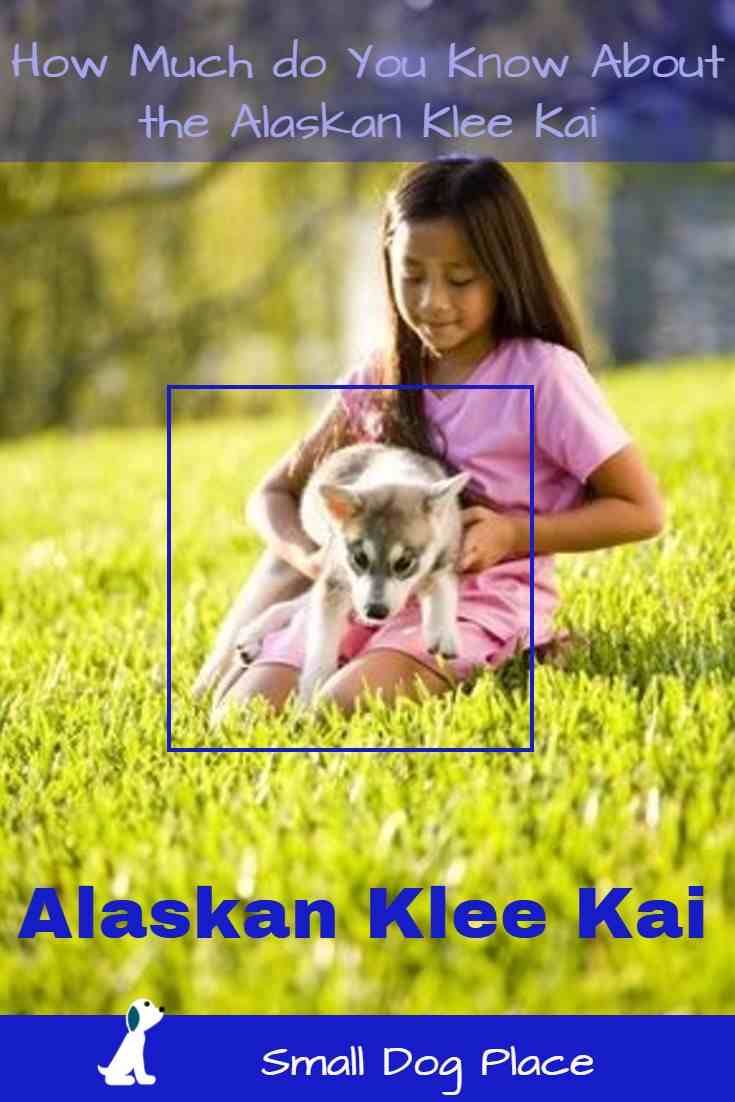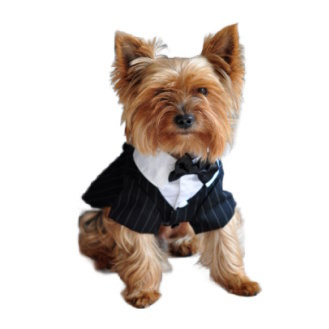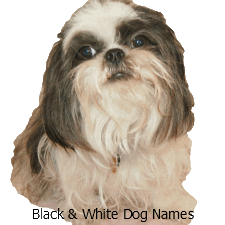Alaskan Klee Kai: Rare, but Adorable
By Janice Jones |Last Updated January 22, 2020
The Alaskan Klee Kai could quite possibly be one of the cutest dogs you lay your eyes on, especially if you’re a fan of the Siberian husky.
They are actually said to be a smaller version of the husky, although they are very similar in physical shape. Much like the Poodle, there are three sizes of Klee Kai, the Toy, Miniature, and Standard.
These cute little guys are known for its distinctive and beautiful face mask and colors. The toy Klee Kai weighs 10 pounds or less. If you want a small fluffy dog, this might be the perfect breed for you.
Having a
10-pound Siberian husky sounds like the perfect and most adorable dog a person
could own, and many people see it that way.
The general appearance of an Alaskan Klee Kai reflects the breed Northern heritage. If you’re in the market for a small, adorable dog that is very loving yet loyal, then the Alaskan Klee Kai is the perfect little dog for you.
Quick Facts
Other Names Used: Klee Kai, AKK
Affiliation: UKC Northern Breeds,
Size: Three Sizes:
Toys: Up to 13 inches at the withers (top of shoulder blades at the base of the neck)
Miniature: 13-15 inches
Standard: 15 to 17 inches; If showing your Klee Kai, a fault is having a dog that is over 17.5 inches at the withers)
Weight: The Breed Standard does not specify a weight range
Coat Type: Standard and full-coated varieties
Colors: They come in three recognized color varieties including black and white, grey and white, and red and white. Recently, solid white color of this breed has become prominent; however, it is not fully recognized by UKC yet.
Country of Origin: United States of America (Alaska)
Activity Level: Moderate-High; the AKK need daily, routine exercise, especially long walks.
Life Expectancy: 12-16 years
Good with Children: If socialized at a very young age, they can be good with children; however, they might be hesitant or cautious.
Some Klee Kais will not put up with the usual antics of a small child or toddler. Their constant tugging, pinching and poking may upset the dog and cause him/her to nip at the small child.
Good with Other Pets: Good with other dogs, however, the AKK must be socialized with small animals and pets such as gerbils, birds, guinea pigs, and any other small pets at a young age if you want them to live in peace with any small animal.
They have such a strong prey drive and will have the need to hunt and kill a small animal if not socialized and trained well as a puppy.
History
The Alaskan Klee Kai is a somewhat new breed, developed in the early 1970s by Linda Spurlin. Spurlin discovered a tiny little gray and white husky, a farm dog owned by one of her relatives in Oklahoma. She persuaded them to let her have him and he became the foundation stock of what was to become an entirely new breed.
The name Klee Kai is derived from the Eskimo words meaning 'little dog' and was given to the breed by their original breeder, Linda Spurlin.
It is uncertain how the breed emerged but it is likely that the Alaskan Husky had a prominent part to play. Alaskan Huskies have become very popular in Alaska in the last 50 years as the ideal dog for pulling sleds.
Prior to that, Siberian Huskies were generally used. Once racing became popular and profitable, Alaskan mushers were determined to get a breed that was superior in strength, endurance and speed.
Linda Spurlin's goal was to create a dog that resembled the Husky, but was smaller in size and was meant to be a companion dog.
Eventually the breed was accepted by many major kennel clubs including Federation of International Canines, the American Rare Breed Association, Canine Rarity Shows, the Alaskan Klee Kai Association of America, and the United Kennel Club.
The Alaskan Klee Kai At a Glance
| Traits | Rating |
|---|---|
| Playfulness | |
| Affection Level | |
| Friendliness Towards Strangers | |
| Good with Children | |
| Good with Other Dogs | |
| Good for First Time Owners | |
| Exercise Needed | |
| Ease of Training | |
| Watch Dog Ability | |
| Grooming Requirements | |
| Shedding | |
| Cold Tolerant | |
| Heat Tolerant |
Explanations for At a Glance Ratings
- Playfulness: Most=5 Less=1
- Affection: Most=5 Least=1
- Friendliness Towards Strangers: Most=5 Least=1
- Good with Children: Good=5 Not Good=1
- Good with Other Dogs: Good=5 Not Good=1
- Good for First Time Owners: Good=5 Not Good=1
- Amount of Exercise Required: Much=5 Minimal=1
- Ease of Training: Easy=5 Difficult=1
- Watch Dog Ability: Excellent=5 Poor=1
- Grooming Needs: Extensive=5 Minimal=1
- Shedding: Heavy Shedding=5 Minimal Shedding=1
- Cold Tolerance: Cold Well Tolerated=5 Poorly Tolerated=1
- Heat Tolerance: Heat Well Tolerated=5 Poorly Tolerated=1
Personality/Temperament
Alaskan Klee Kai are very loving and loyal dogs, but do require quite a lot of socialization and special care as puppies.
Without proper socialization and exercise, they can become high strung, but in the appropriate home, these loving dogs can be the perfect companions for a lot of people.
They are a bit reserved with strangers, but are very loving and fun once they get to know you. It cannot be stressed enough that they need to be socialized well.
Some, who have not had early training or socialization, like to take on the role of leader of the pack, which can lead to Small Dog Syndrome.
The ideal owner is one that uses a positive reinforcement mode of training. They want to be your friend and they don't need an owner that is going to assume the role of Alpha delivering harsh punishment.
They are very alert and vocal. These characteristics along with their inborn tendencies to be wary of strangers make them outstanding watchdogs.
These dogs, like many of their Spitz-type cousins are highly intelligent and can get bored easily if not given enough challenges or a job to do. If you are interested in dog sports, this breed performs well in Agility, Rally, Lure coursing, Obedience, and Weight pulling.
They are also very active, especially outdoors and need plenty of exercise. A couple long walks coupled with some vigorous playtime in a well fenced in area will keep your Klee Kai happy and in shape.
They have an extremely strong drive to please, and as well as being very intelligent, this makes training usually very easy.
Alaskan Klee Kai also have a strong prey drive which means, they will feel the need to hunt and kill any small animal or rodent.
It is highly encouraged to expose your AKK to gerbils, birds, small dogs or other small pocket type pets from an early age. Dogs with a strong prey drive should not be allowed off leash as they are very likely to chase anything that moves.
As friendly as they can be, Alaskan Klee Kai also need to be socialized to work with children, if they are going to be a presence in their life.
They naturally will not like small children poking them or tugging on their tail, but again, with proper socialization, they can work very well with children. They do much better with older children who are respectful and have learned how to interact appropriately with dogs.
If you do not want a vocal breed, then the Alaskan Klee Kai may not be for you. They love to communicate, and some owners claim to have conversations with their pup.
This is one of the reasons that they make such great watchdogs, however, if you are an apartment or condo dweller; this may not be the breed for you.
Grooming
Since this breed is a seasonal shedder, usually shedding between the months of January to June. During this seasonal shed, they should be at least brushed daily. They don’t shed an obscene amount, and are considered average shedders.
They have a double coat, which is why they need the daily grooming, and they also blow their coat twice a year. During this time, they lose all of their fur.
Alaskan Klee Kais often like to groom themselves and are the type of breed that doesn’t like to get their “feet wet.” This means that they will lick themselves and rub against furniture, fences, etc during the time that they blow their coat.
Brushing is really the most important grooming task because their coat is thick and brushing helps remove old dead hairs, lives them looking better and their coat shiny. Brushing and combing also prevents mats from forming.
The best tools for grooming include a pin brush and a metal comb. Combs with wide teeth are best for overall combing, but you may also want to go over the coat with a fine toothed comb such as a flea comb.
Along with any other breed, they will also need regular bathing, nail clippings, teeth brushings, and ear checks. However, with proper grooming and attention, they will be beautiful and fluffy friends.
As with all breeds, puppies should be introduced to grooming from an early age, even if grooming is not really necessary. If you wait until the puppy is older, you are likely to have a dog that hates or even refuses to be groomed.
Health Concerns of the Alaskan Klee Kai Dog Breed
The Alaskan Klee Kai is a generally very healthy breed and do not have many genetic defects. They can be prone to sensitive stomachs, but that can be easily monitored and fixed with special dog food, or medicine.
The best way to assure that you get a healthy Klee Kai is to search for a reputable breeder who screens for health problems associated with the breed.
Several of the tests recommended for AKK breeding dogs include thyroid, patellar luxation, a cardiac exam, eye exam by a veterinary ophthalmologist (now OFA, which has replaced the Canine Eye Registration Foundation, CERF) and Factor VII.
Factor VII is a blood disorder that can cause excessive bleeding. Remember that these tests are done on the parent dogs (Dame and Sire) and not on the puppies.
Good breeders do not use dogs that fail any of these tests in their breeding program. Any health concern that you suspect should be mentioned to your vet immediately.
- Cataracts
- Liver Disease
- Luxating Patella
- Thyroid Disease
- Factor VII Bleeding Disorder
Pros:
- Make good watchdogs
- Very loyal to their owners
- Intelligence makes them easy to train
- Housebreaking is also easy due to intelligence
- Affectionate
Cons:
- Cautious around strangers and new situations
- Can be vocal
- They have a strong prey drive making them unreliable off leash
- Extreme separation anxiety
- Shedding may be a problem during months of shedding
- Very rare. Be prepared to wait for the right dog to come along.
Did You Know?
Well-known actress and pop star, Miley Cyrus owned an Alaskan Klee Kai named Floyd.
Breed Club:
Keep Searching for the Perfect Breed:
Go from Alaskan Klee Kai to A to Z Breed List
For Those Interested in the Breed
Need a Great Name for your AKK?
About Janice (author and voice behind this site)
Having lived with dogs and cats most of her life, Janice served as a veterinary technician for ten years in Maryland and twelve years as a Shih Tzu dog breeder in Ohio.
Her education includes undergraduate degrees in Psychology with a minor in biology, Early Childhood Education, and Nursing, and a master's in Mental Health Counseling.
She is a lifelong learner, a dog lover, and passionate about the welfare of animals. Her favorite breed for over 50 years has been the Shih Tzu, but she has also lived with poodles, Maltese, Yorkshire Terriers, beagles, English bulldogs, carin terriers, and a Cocker Spaniel.
When not writing, reading, and researching dog-related topics, she likes to spend time with her eight Shih Tzu dogs, husband, and family, as well as knitting and crocheting. She is also the voice behind Miracle Shih Tzu and Smart-Knit-Crocheting
Does This Article Deserve Your Thumbs Up?
We always appreciate your support and encouragement. Your thumbs up means so much to us. Please like this article.
If you find this page or any page on Small Dog Place Helpful, or useful in anyway, I'd love it if you would click the small heart found on the bottom right of each page.
You can also share or bookmark this page -- just click on the:

Free Monthly Newsletter
Sign Up for Our Free Newsletter and get our Free Gift to You.
my E-book, The Top 10 Mistakes People Make When Choosing a Dog (and how to avoid them)
